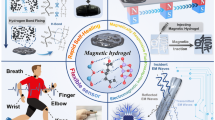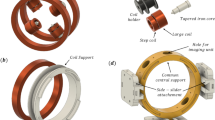Abstract
Acquisition of images without surgical interposition into human body was possible due to magnetic resonance imaging (MRI) mechanism. We introduced noteworthy properties of specific combination of copper surface coils as tunable hybridized magnetic metamaterial hat (THMMH). In THMMH, some of the surface coil slots were loaded with capacitor elements and parallel merger of discrete edge ports as externally applied sinusoidal steady-state current source (IS). We highlighted the significance of IS, as it could make the design tunable and reconfigurable without any requirement of it being re-designed/re-fabricated. Efficiency comparison between THMMH and previously reported work (un-tunable hybridized magnetic metamaterial hat, HMMH) was analyzed. We concluded that THMMH exhibited better magnetic field (B-field) and SNR into region of interest (ROI) at the rat’s brain, as well as shown strong resonance in comparison to previously reported work on the rat’s brain imaging for 7-T MRI. In addition, THMMH excited two eigenmodes simultaneously, which exploited its properties as hybridized magnetic material. Furthermore, relative negative permeability, μr = − 3.5+j20.2 for THMMH as case I and μr = − 5.5+j36.3 for un-tunable HMMH as case II were achieved at 300 MHz for 7-T MRI and for comparison purpose.













Similar content being viewed by others
References
Lauterbur PC (1973) Image formation by induced local interactions: examples employing nuclear magnetic resonance. Nature 242:190–191
Hendee WR (1999) Physics and applications of medical imaging. Rev Mod Phys 71:S444–S450
Logothetis NK (2008) What we can do and what we cannot do with fMRI. Nature (London) 453:869–878
Ma D, Gulani V, Seiberlich N, Liu K, Sunshine J, Duerk J, Griswold M (2013) Magnetic resonance fingerprinting. Nature 495:187–192
Degen CL, Poggio M, Mamin HJ, Rettner CT, Rugar D (2009) Nanoscale magnetic resonance imaging. PNAS 106:1313–1317
Haacke EM, Brown RW, Thompson MR, Venkatesan R (1999) Magnetic resonance imaging: physical principles and sequence design (vol 82). Wiley-liss, New York
Vaughan T, DelaBarre L, Snyder C, Tian J, Akgun C, Shrivastava D, Anderson P (2006) 9.4 T human MRI: preliminary results. Magn Reson Med 56:1274–1282
Jouvaud C, Abdeddaim R, Larrat B, de Rosny J (2016) Volume coil based on hybridized resonators for magnetic resonance imaging. Appl Phys Lett 108:023503
Sodickson DK, Manning WJ (1997) Simultaneous acquisition of spatial harmonics (SMASH): fast imaging with radiofrequency coil arrays. Magn Reson Med 38:591–603
Pruessmann KP, Weiger M, Scheidegger MB, Boesiger P (1999) Coil sensitivity encoding for fast MRI. Magn Reson Med 42:952–962
Roemer PB, Edelstein WA, Hayes CE, Souza SP, Mueller OM (1990) The NMR phased array. Magn Reson Med 16:192–225
Brunner D, De Zanchei N, Frohlich J, Paska J, Pruessmann K (2009) Travelling-wave nuclear magnetic resonance. Nature 457:994–998
Ali H, Jun H, Abbas A, Tariq M et al (2017) −μ compact magnetic metamaterial lens for 0.35-T MRI. J Opt 46:436–445
Kuperman V (2000) Magnetic resonance imaging. Physical Principles and Applications. Academic Press, San Diego
Hogemann D, Josephson L, Weissleder R, Basilion JP (2000) Improvement of MRI probes to allow efficient detection of gene expression. Bioconjug Chem 11:941–946
Stafford RJ (2005) TU-B-I-617-01: high field MRI—technology, applications, safety, and limitations. Med Phys 32(6):2077–2077
Solis SE, Wang R, Tomasi D, Rodriguez AO (2011) A multi-slot surface coil for MRI of dual-rat imaging at 4 T. Phys Med Biol 56:3551–3561
Hayes CE, Edelstein WA, Schenck JF, Mueller OM, Eash M (1985) An efficient, highly homogeneous radiofrequency coil for whole-body NMR imaging at 1.5 T. J Magn Res 63:622–628
Katscher U, ornert PB€ (2006) Parallel RF transmission in MRI. NMR Biomed 19:393–400
Belov P, Zhao Y, Sudhakaran S, Alomainy A, Hao Y (2006) Experimental study of the sub-wavelength imaging by a wire medium slab. Appl Phys Lett 89:262109
Pendry JB (2000) Negative refraction makes perfect lens. Phys Rev Lett 85:3966–3969
Smith DR, Pendry JB, Wiltshire MCK (2004) Metamaterials and negative refractive index. Science 305:794–799
Baena JD, Jelinek L, Marques R, Silveirinha M (2008) Unified homogenization theory for magnetoinductive and electromagnetic waves in split-ring metamaterials. Phys Rev A 78:013842
Engheta N, Ziolkowski RW (eds.) (2006) Metamaterials: physics and engineering explorations. John Wiley & Sons, Hoboken
Cai W, Shalaev V (2010) Optical metamaterials: fundamentals and applications. Springer, New York
Freire M, Marqués R, Jelinek L (2008) Experimental demonstration of a μ=− 1 metamaterial lens for magnetic resonance imaging. Appl Phys Lett 93:231108
Marques R, Mesa F, Martel J, Medina F (2003) Comparative analysis of edge-and broadside-coupled split ring resonators for metamaterial design-theory and experiments. IEEE Trans Antennas Propag 51:2572–2581
Ali H, Forsberg E, Jun H (2016) Sub-wavelength imaging with BC-SRRs metamaterial lens for 1.5-T MRI. Appl Magn Reson 47:539–554
syms RRA, Floume T, Young I, Solymar L, Rea M (2010) Flexible magnetoinductive ring MRI detector: design for invariant nearest-neighbour coupling. Meta 4:1–14
Radu X, Garray D, Craeye C (2009) Toward a wire medium endoscope for MRI imaging. Meta 3:90–99
Ali H, Forsberg E, Jun H (2017) Brain imaging with slotted hybridized magnetic metamaterial hat at 7-T MRI. Appl Magn Reson 48(1):67–83
Liu L, Kang L, Mayer TS, Werner DH (2016) Hybrid metamaterials for electrically triggered multifunctional control. Nature Comm 7:13236
Zheludev NI, Plum E (2016) Reconfigurable nanomechanical photonic metamaterials. Nature Nano Tech 11:16–22
Babic S, Akyel C (2008) Magnetic force calculation between thin coaxial circular coils in air. Mag IEEE Trans 44:445–452
Brillouin L (1960) Wave propagation and group velocity. Academic press, New York and London
https://www.rigolna.com/products/waveform-generators/dg5000/
Aprille JT, Timothy NT (1972) Steady-state analysis of nonlinear circuits with periodic inputs. Proc IEEE 60(1):108–114
Podolskiy VA, Kuhta NA, Milton WG (2005) Optimizing the superlens: manipulating geometry to enhance the resolution. Appl Phys Lett 87:231113
Sievenpiper DF, Sickmiller ME, Yablonovitch E (1996) 3D wire mesh photonic crystals. Phys Rev Lett 76:2480–2483
Marqués R, Martín F, Sorolla M (2008) Metamaterials with negative parameters: theory and microwave applications. Wiley & Sons Inc., Hoboken
Abdeddaim R, Ourir A, de Rosny J (2011) Realizing a negative index metamaterial by controlling hybridization of trapped modes. Phys Rev B 83:033101
Syms RRA, Solymar L, Young IR (2008) Three-frequency parametric amplification in magneto-inductive ring resonators. Meta 2:122–134
Sydoruk O, Shamonina E, Solymar L (2007) Parametric amplification in coupled magnetoinductive waveguides. J Phys D Appl Phys 40:6879–6887
Hadjicosti K, Sydoruk O, Maier SA, Shamonina E (2015) Surface polaritons in magnetic metamaterials from perspective of effective-medium and circuit models. J Appl Phys 16:163910
Valkenburg V (1958) Network analysis. Prentice-Hall, London
Lapine M, Jelinek L, Marqués R, Freire M (2010) Exact modelling method for discrete finite metamaterial lens. IET Microw Antennas Propag 4:1132–1139
Kim G, Lee B (2016) Synthesis of bulk medium with negative permeability using ring resonators. J Electro Magn Engg Sci 16(2):67–73
Hall SH, Heck HL (2009) Advanced signal integrity for high-speed digital designs. Hoboken Wiley, New Jersey
Balanis CA (2012) Advanced engineering electromagnetics, 2nd edn. Wiley, Hoboken
Reed DG (2005) ARRL handbook for radio Communications, 82nd edn. American Radio Relay League, Newington
Thierauf SC (2004) High-speed circuit board signal integrity. Artech House, Norwood, MA
Wensong W, Chen Y, Yang S, Zheng X, Cao Q (2015) Design of a broadband electromagnetic wave absorber using a metamaterial technology. J Electromagn Waves and Appl 29:2080–2091
Tan S, Yan F, Sing L, Cao W, Xu N, Hu X, Zhang W (2015) Terahertz metasurfaces with a high refractive index enhanced by the strong nearest neighbor coupling. Opt Express 23(22):29222–29230
Chen XD, Grzegorczyk TM, Wu BI, Pacheco J Jr, Kong JA (2004) Robust method to retrieve the constitutive effective parameters of metamaterials. Phys Rev E 70:016608
Maslovski S, Tretyakov S, Alitalo P (2004) Near-field enhancement and imaging in double planar polariton-resonant structures. J Appl Phys 96:1293–1300
Algarin JM, Lopez MA, Freire MJ, Marques R (2011) Signal-to-noise ratio evaluation in resonant ring metamaterial lenses for MRI applications. New J Phys 13:115006
Hoult DI, Richards RE (1976) The signal-to-noise ratio of the nuclear magnetic resonance experiment. J Magn Reson 24:71–85
Ali H, Forsberg E, Jun H (2017) 0 μ magnetic polarizer for 1.5-T MRI. J Electr Electron Syst 6:242
Edelstein WA, Glover GH, Hardy CJ, Redington RW (1986) The intrinsic signal-to-noise ratio in NMR. Reson Med 3:604–618
Rosa FB, Grover FW (1948) Formulas and tables for calculation of mutual and self-inductance. Bureau of Standards. Government Printing Office, Washington
Landau LD, Lifschitz EM (1984) Electrodynamics of continuous media. Pergamon Press, Oxford
Nightingale NRV, Goodridge VD, Sheppard RJ, Christie JL (1983) The dielectric properties of the cerebellum, cerebrum and brain stem of mouse brain at radiowave and microwave frequencies. Phys Med Biol 28(8):897
Funding
The author is grateful for the partial supports from NSFC 61271085 (National Natural Science Foundation of China).
Author information
Authors and Affiliations
Corresponding author
Rights and permissions
About this article
Cite this article
Ali, H. Modeling of Electrically Triggered Tunable Magnetic Metamaterial Hat for Multifunctional Control in MRI Applications. Plasmonics 14, 91–107 (2019). https://doi.org/10.1007/s11468-018-0781-8
Received:
Accepted:
Published:
Issue Date:
DOI: https://doi.org/10.1007/s11468-018-0781-8




